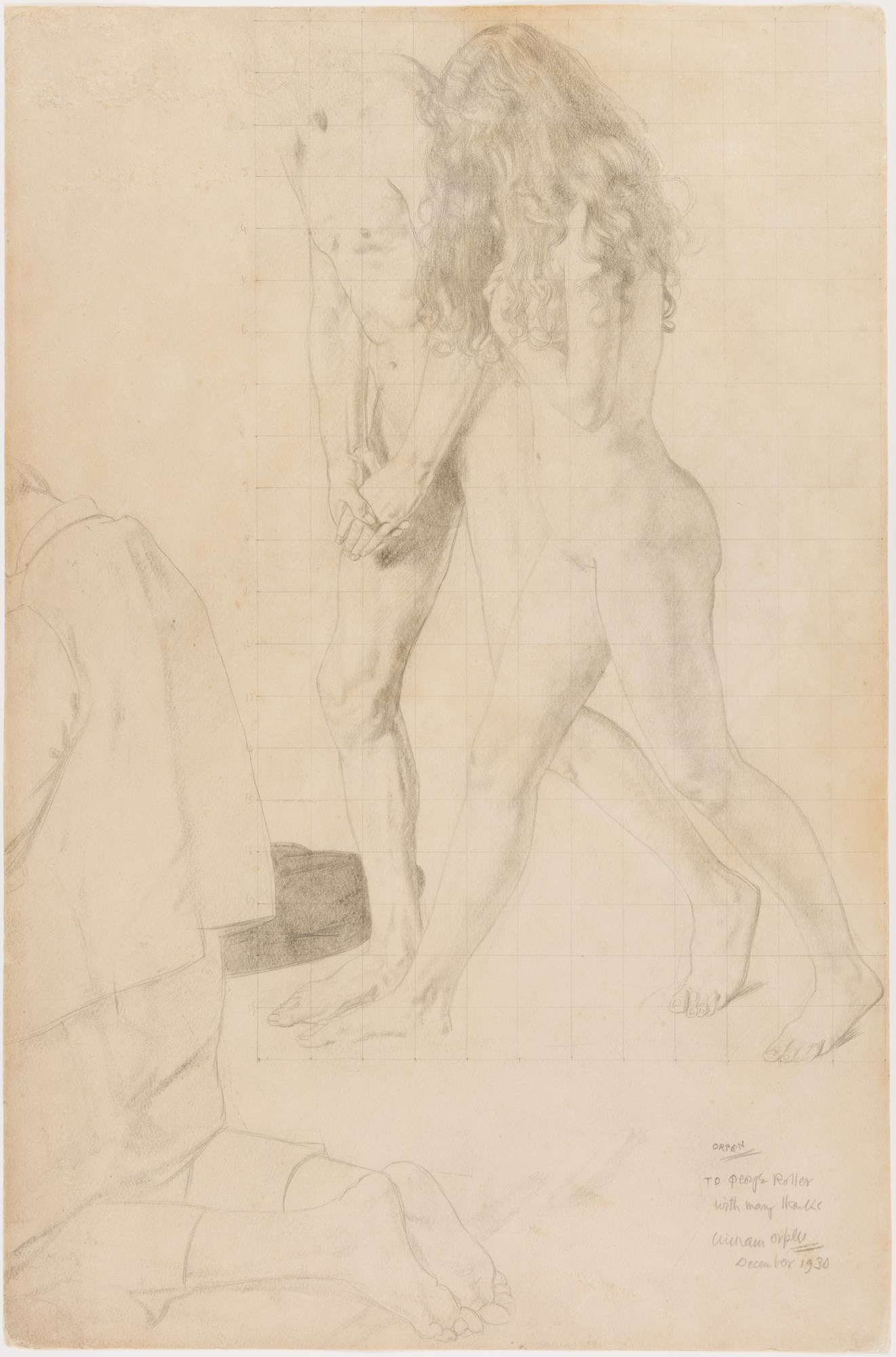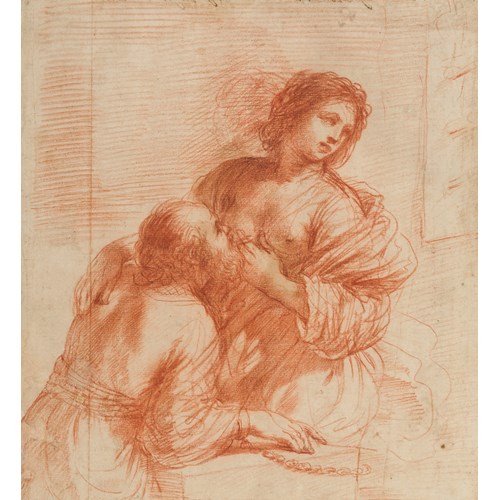William ORPEN
Study for The Holy Well: A Nude Couple and a Kneeling Man
Date December 1930
Period 20th century
Origin UK
Medium Pencil, Black chalk on buff paper
Dimension 64.7 x 42.5 cm (25¹/₂ x 16³/₄ inches)
This large drawing is a preparatory study for the two nude figures at the centre of William Orpen’s large paintingThe Holy Well (Nude Pattern), completed in 1916 and today in the collection of the National Gallery of Ireland in Dublin. The Holy Well was the last, and arguably the most important, of three major allegorical pictures of Irish subjects painted by Orpen between 1913 and 1916, the others being Sowing New Seed, now in the Mildura Arts Centre in Victoria, Australia, and The Western Wedding, which was last recorded in a Japanese collection and is presumed to have been destroyed during the Second World War. Each of these three paintings – a group sometimes referred to as the ‘Irish Trilogy’, and described by one modern biographer as Orpen’s ‘strange and disturbing Irish valediction’ – were painted with a flat, tempera-like finish, and were preceded by a series of large figure studies in pencil that attest to the importance the artist placed on these canvases.
Orpen seems to have intended The Holy Wellas an allegory of the Celtic customs, morals and religious practices of his native Ireland, and the composition may have been inspired in part by John Millington Synge’s play The Well of the Saints. A large painting, measuring over 8 1/2 by 7 feet, The Holy Well(which the artist, in his correspondence, also referred to by the title ‘Nude Pattern’) depicts the naked figures of the pagan Celtic people of ancient Ireland who, made to drink from a well, are thereby transformed into Christian Aran islanders. The background depicts Celtic crosses and native dwellings of the 6th and 7th centuries, and the scene is dominated by the figure of Orpen’s pupil and assistant Seán Keating, standing on a wall and surveying this ritual with an expression of benign cynicism. It was in fact Keating who seems to have inspired the painting, since he had spent the summer of 1915 painting in the Aran Islands, in Galway Bay, and had returned to London with paintings and drawings of the area, as well as a selection of local costumes, which Orpen used for his picture.
Orpen’s biographer P. G. Konody described The Holy Well as ‘a fascinating, whimsical, somewhat scattered design of men and women – some of them amusingly reminiscent of Rodin – in every stage of complete or partial déshabille, gathered around the miraculous spring.’ A recent scholar has noted that the painting ‘has been read as an ironic complaint against the Church, as if an allegory; but Orpen’s persistent use of humour is difficult to interpret. He had rarely used life studies in his paintings, and follows [Augustus] John both in this and in the drama of unrestrained nudity versus the decorum of dress. It was presumably the Irish revival as well as the war in Europe that led him to take up a grand style, and to plan so elaborately. His artist friend Sean Keating, depicted standing over the well, is defiantly modern and quizzical, and the figures below seem to represent an expulsion from their paradise.’
As he had for Sowing New Seed and The Western Wedding, Orpen devoted a considerable amount of time to making careful preparatory drawings for The Holy Well, both for individual figures and groups of figures. As Seán Keating recalled of The Holy Well, ‘The drawings from which he painted the figures were done in lead pencil on smooth white paper, the tones rubbed in with a paper stump. Orpen greatly admired Ingres’ drawings whom he rather resembled in looks but in my opinion they are finer than Ingres’, tho’ it is considered heresy to say so.’ A fine example of the artist’s draughtsmanship of this period, the present sheet must have been drawn fairly early in the process of developing the composition of the painting, since the kneeling figure at the lower left does not appear in the final work.
Exhibited at the New English Art Club in 1916, Orpen’s painting of The Holy Wellwas purchased for the sum of £2,000 by the artist’s wealthy American patron and mistress, Florence Evelyn St. George, who also acquired seventeen large preparatory studies for the picture. The painting was hung on the staircase of her London residence, Cam House in Kensington, and, together with its preparatory drawings, was lent by her to the retrospective exhibition of Orpen’s work held at the Royal Academy in 1933. After Mrs. St. George’s death, The Holy Well, together with the rest of her collection and the contents of Cam House, was sold at auction in London in July 1939, and was eventually acquired by the National Gallery of Ireland in 1971.
As P. G. Konody has noted of the paintings that make up the ‘Irish Trilogy’, ‘These decorative compositions, with all their unconventionality and whimsical waywardness of spirit, were deliberately planned works, the result of much thought and numerous preliminary studies.’ Orpen’s large pencil studies for various figures in The Holy Well, sometimes enlivened with added touches of watercolour, are characterized by a particular sensitivity and meticulous technique. The artist’s studio book lists a number of preparatory drawings for The Holy Wellwith names against them, suggesting that they may have been reserved for buyers other than Mrs. St. George, but it is unclear whether all were in fact dispersed, since some, like the present sheet, may well have remained in his studio for many years after the painting was completed. As the artist’s dedicatory inscription at the lower right attests, the present sheet was presented by Orpen to a friend in 1930, some nine months before his death. Other preparatory drawings by Orpen for The Holy Wellare today in the National Gallery of Ireland in Dublin, the Metropolitan Museum of Art in New York, and in several private collections.
Date: December 1930
Period: 20th century
Origin: UK
Medium: Pencil, Black chalk on buff paper
Signature: Signed ORPEN in pencil at the lower left centre.
Signed, dated and dedicated To George Roller / with many thanks / William Orpen / December 1930 in pencil at the lower right.
Dimension: 64.7 x 42.5 cm (25¹/₂ x 16³/₄ inches)
Provenance: Given by the artist to George Roller, in December 1930
Supposedly given by him to the jockey Joseph (‘Joe’) Childs, Portsmouth
Thence by descent.
More artworks from the Gallery









